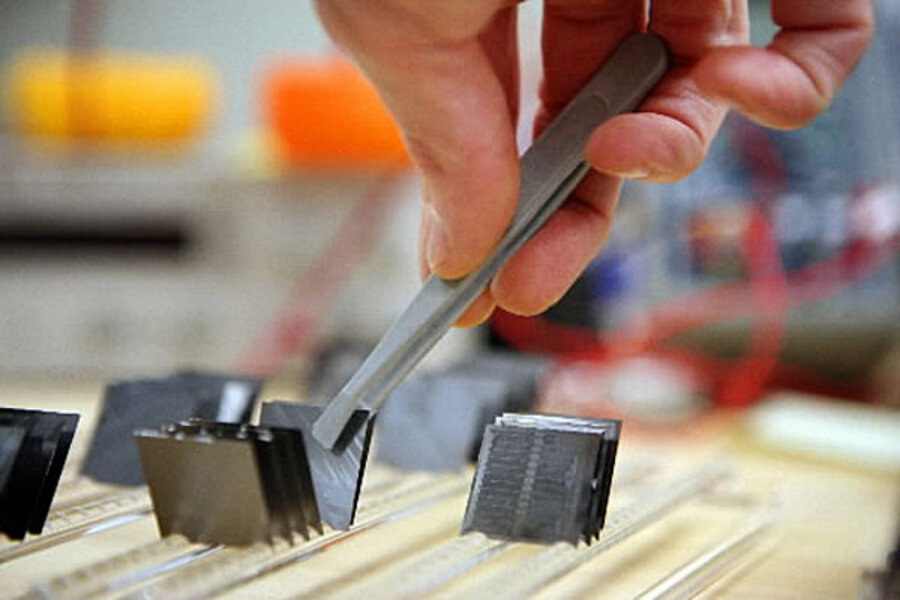US boosts 'game-changer' solar technology in bid for global market share
Solar power as cheap as coal, that's the holy grail of the solar power industry.
It’s an elusive goal that has more than a few skeptics saying solar – no matter how much advocates pump it – will always remain the energy source of the future, and not the present.
“They're always just five years off no matter what year it is, in order to justify continued subsidies,” said a Wall Street Journal editorial last July, referring to photovoltaic and other renewable energy sources. Solar is “a speculative and immature technology that costs far more than ordinary power.”
But the US Department of Energy isn't buying that – just the opposite. In the past two years the Energy Department has offered over $12 billion in loan guarantees for 16 solar projects – about two thirds of the recipients are power plants, the rest are solar manufacturers – with stimulus funds from the 2009 American Recovery and Reinvestment Act.
Friday the DOE once again hammered home its view that solar’s promise is real, with a $150 million loan guarantee to 1366 Technologies, a Lexington, Mass.-based solar wafer manufacturing company that has a great new technology – but no manufacturing plant. Now it will.
“This project is a game-changer that could dramatically lower the cost of photovoltaic solar cells,” said Energy Secretary Steven Chu. “As global demand for solar cells increase, this kind of technology will help the US increase its market share.”
For 1366 Technologies – the company is named for the amount of energy in watts that strikes the earth’s atmosphere per square meter – the DOE’s vote of confidence is a big deal. The company, started in 2007 on the idea of MIT professor Emanuel Sachs, will now finally be able to demonstrate in production a technology that company officials say could vault the US to technological leadership in the manufacturing of solar cells.
Using an innovative process, the company plans to cast silicon wafers for solar panels directly from the molten output of an industrial furnace – rather than cut ingots of pure silicon with a special saw. That change alone saves fully half of the high-cost silicon usually wasted in that process. In addition, the company has figured out how to coat its wafers with materials that boost their efficiency.
“With this loan, 1366 will realize its goal to make solar energy as cheap as coal while helping the US to reclaim a key part of the silicon supply chain and restore the nation's dominance in photovoltaics,” Frank van Mierlo, 1366’s president, said in a statement.
Part of the plan is not only to manufacture the photovoltaic cells more efficiently but also to produce at least a three percentage point gain in the solar cells’ output. Their goal is to reduce the cost of manufacturing a photovoltaic cell to less than $1 per watt.
With the federal loan guarantee, the company is already scouting for a site for its first production plant, which it hopes will be manufacturing 200 megawatts of wafers annually by 2013. Right on the heels of that, it plans to build another facility capable of producing a 1,000 megawatts of wafers per year.
Solar power advocates say there are signs that the industry is on track to be competitive, though costs still need to be cut.
“There's tremendous progress being made in the solar power industry with costs of photovoltaics coming down dramatically,” says Robert Margolis, a senior energy analyst for the National Renewable Energy Laboratory. “Solar module [panel] prices are dropping rapidly this year – about 10-20 percent already this year – and expected to continue dropping rapidly.”
For solar power to compete without subsidies with coal, the Department of Energy says, the installed cost of solar energy modules needs to drop another 75 percent.
At the current rates of declining cost, the DOE and others project, solar will be competitive with coal in 2020.
At that point, the DOE website says, there will be “rapid, large-scale adoption of solar electricity across the United States.”
Pie in the sky? Advocates say new funding from DOE and billions already invested by venture capitalists will allow solar companies to keep chipping away at the industry’s cost structure.
“For folks that haven't been following the industry and are thinking about what solar was a decade ago – they have no idea of what's coming,” Dr. Margolis says. “A lot of people are going to be caught by surprise.”





